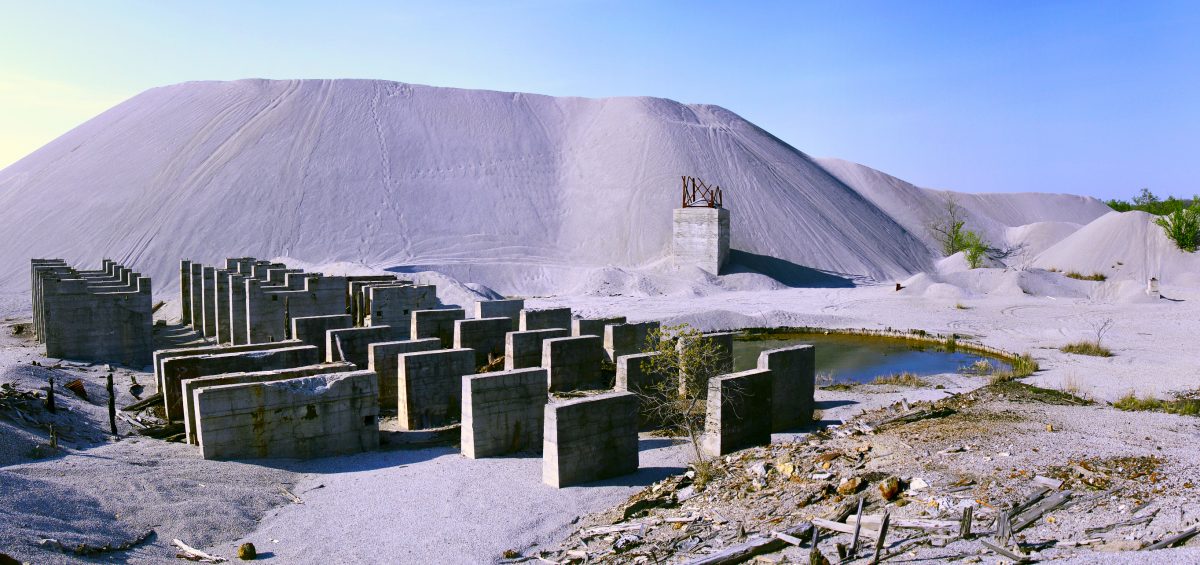Cleanup History:
Tar Creek was added to the National Priorities (Superfund) list in 1983. Various attempts to deal with the surface water contamination were made in the 80s and 90s. In 2000, Governor Frank Keating commissioned a study to develop a comprehensive remediation plan for the area. In 2002, DEQ studied metals concentrations in fish from waters impacted by the Tri-State Mining District, including Tar Creek. Fish consumption advisories were issued as a result.
In 2005, the State of Oklahoma, under the Oklahoma Plan, began cleaning up some contaminated areas and restored 329 acres of land to beneficial use. In 2006, the State of Oklahoma passed legislation that allowed for the voluntary buyout of citizens with children in the area. In 2010, EPA began the implementation of the Operable Unit (OU) 4 Record of Decision (ROD) work that involves remediating properties to allow for beneficial reuse and voluntary buyout of citizens of the Relocation Assistance Zone.
Chat has been sold as road building material and has been widely used as fill material but approximately 30 million tons of chat remain in the Tar Creek area. The University of Oklahoma’s Center for Restoration of Ecosystems and Watersheds (CREW) has partnered with DEQ on two projects to bioremediate groundwater discharging from abandoned mines. This treatment process uses a series of wetland ponds to naturally remove lead, zinc, cadmium, and iron from the water, and then discharges it into a tributary of Tar Creek. DEQ, EPA, and the Quapaw Nation continuously work with local communities, public, and private organizations within the Tri-State area, to monitor the effects of remaining mine wastes and implement projects that promote better land, water, and air quality.
Status:
- Operable Unit 1 Groundwater: This OU is in the Operations and Maintenance (O&M) phase. As part of O&M activities, DEQ conducts annual groundwater monitoring and inspection of diversion dike structure. DEQ also continues to plug abandoned wells in order to protect the local drinking water aquifer.
- Operable Unit 2 Residential Properties and High Access Areas: This OU is in Remedial Action phase. Since 1997, EPA,the City of Commerce, and DEQ have tested and remediated yards, alley ways, and public areas throughout Ottawa County. Approximately 3,000 residential properties and high access areas have been remediated since the initiation of remedial efforts. In addition, blood lead screening and community health education continues under the direction of the Ottawa County Health Department. Any residential properties in Ottawa County that have not previously been sampled and/or cleaned up can contact DEQ for free yard testing (See Above).
- Operable Unit 3 Drum removal in Cardin: This operable unit has been completed.
- Operable Unit 4 Chat Piles, Other Mine and Mill Wastes, Smelter Wastes: Cleanup is ongoing and to date has been concentrated in the distal areas of the Site. This has resulted in the remediation of approximately 4,800 acres with over 7.1 million tons of source material being removed and disposed at the Central Mil Repository. In addition, 1.25 million tons of source material has been marketed. Remediation will continue with a focus on the Elm Creek and Beaver Creek watersheds.
Voluntary Buyout of citizens within the Relocation Assistance Zone has been completed. Between 2006 and 2010, approximately 530 properties were bought out by the Lead-Impacted Communities Relocation Assistance Trust (LICRAT). Bought-out properties included homes, lots, and buildings owned by both residents and business owners. Ownership of these properties was transferred to LICRAT for demolition and ultimately to the Quapaw Nation for re-use.
- Operable Unit 5 Surface Water and Sediment: EPA Regions 6 and 7 are coordinating with three states (Oklahoma, Missouri, and Kansas), nine Tribes (Quapaw Nation, Peoria Tribe, Ottawa Tribe, Miami Tribe, Eastern Shawnee Tribe, Modoc Tribe, Wyandotte Nation, Seneca-Cayuga Nation, and Cherokee Nation), and the local communities to characterize sediment and surface water throughout the Spring River and Neosho River watersheds. EPA recently released the Final Revised Human Health Risk Assessment and is currently working on the Remedial Investigation (RI) and Feasibility Study.
Activities across the watersheds include data gap sampling to support the RI and additional risk assessment; data gap sampling to support sediment modeling; pilot study implementation to provide data to support evaluation of potential cleanup technologies; and watershed sampling at gaging stations across the area to support modeling efforts.
Did You Know?
The lead and zinc produced at Tar Creek was used to make bullets during both World Wars.


